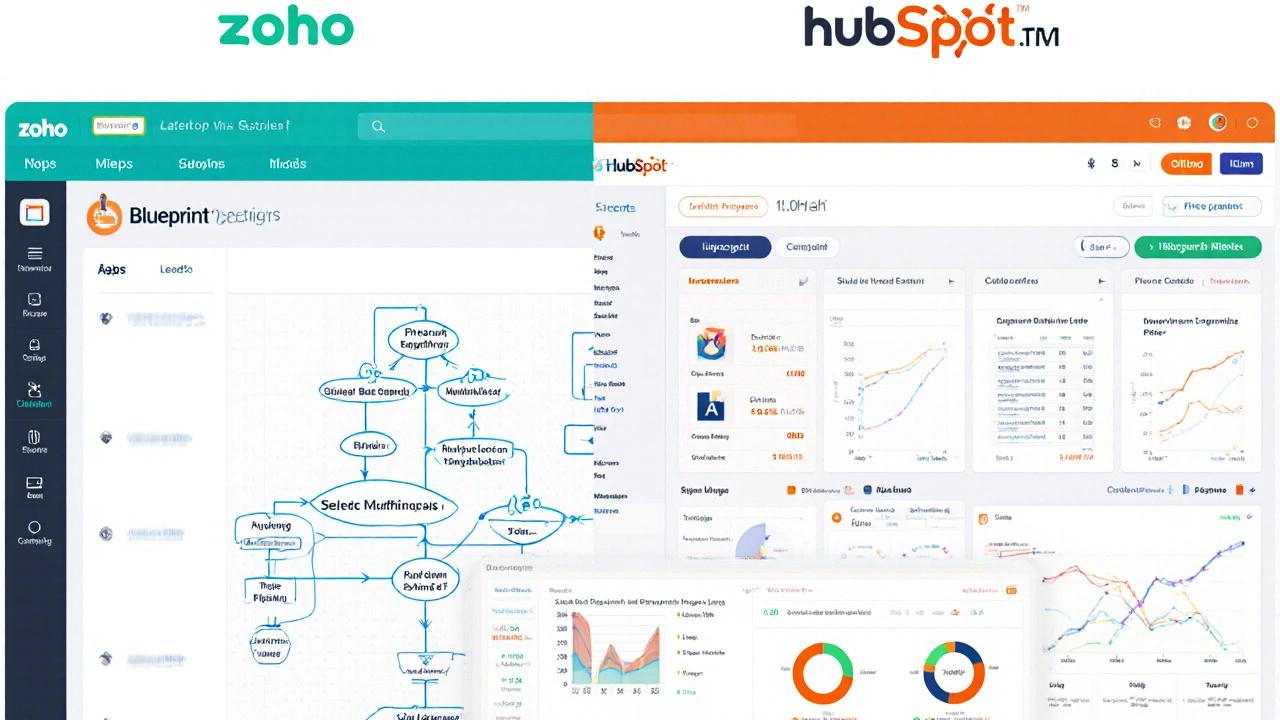CRM Cost Calculator for UK Businesses
Compare Zoho vs HubSpot Costs
This calculator uses the pricing information from the article. Zoho's Standard tier starts at £9/user/month with unlimited contacts. HubSpot offers a free tier for up to 1,000 contacts, with paid tiers starting at £38/user/month for 2,000 contacts.
Choosing a best CRM UK solution feels like a high‑stakes decision for any growing company. Two names dominate the conversation: Zoho and HubSpot. Both promise to centralise sales, marketing and support, yet they differ in pricing, feature depth and how they handle UK‑specific concerns like GDPR. This guide breaks down the most critical factors so you can decide which platform fits your business today and tomorrow.
What we compare and why it matters
Before we dive into the details, let’s set the yardsticks we’ll use. Every CRM can be judged on the same core pillars, but the weight each pillar carries varies for UK SMEs, mid‑market firms and large enterprises.
- Core functionality - lead capture, pipeline management, automation, reporting.
- Pricing structure - per‑user cost, free tier limits, hidden fees.
- Ease of use and onboarding - learning curve, UI clarity, migration tools.
- Integration ecosystem - native apps, third‑party connectors, API depth.
- Support and UK compliance - local phone support, data residency, GDPR tools.
With these criteria in mind, we’ll walk through how each platform stacks up.
Introducing the two contenders
When a reviewer first meets Zoho CRM is a cloud‑based customer relationship management system that targets small to mid‑size businesses with a modular, low‑cost approach. Launched in 2005, Zoho now sits inside a broader suite of over 40 business apps, all sharing a single login.
In contrast, HubSpot CRM is a free‑forever CRM that serves as the hub for HubSpot’s Marketing, Sales and Service Hubs, each sold as separate add‑ons. Founded in 2006, HubSpot emphasizes inbound marketing and provides a sleek, “no‑code” experience.
Both platforms claim to be CRM software that helps companies turn leads into loyal customers, but the way they deliver that promise differs dramatically.
Feature deep dive: core functionality
Lead capture & pipeline - Zoho offers customizable pipelines, stage‑specific fields and a visual drag‑and‑drop builder. HubSpot’s pipeline feels more streamlined, with automatic stage progression based on user activity. If you need highly tailored stages for a complex B2B sales cycle, Zoho wins; for a fast‑moving B2C operation, HubSpot feels smoother.
Automation - Zoho’s Blueprint workflow engine lets you map out multi‑step processes with conditional branching, ideal for compliance‑heavy industries. HubSpot’s automation is limited to a maximum of 1,000 contacts on the free tier and 5,000 on the Starter plan, but its visual editor is more beginner‑friendly.
Reporting & analytics - Zoho provides over 50 pre‑built reports and a powerful analytics canvas that can combine CRM data with finance and inventory data from other Zoho apps. HubSpot’s reporting dashboard is clean but leans heavily on marketing metrics; deep custom reports require the Professional or Enterprise Sales Hub.
Mobile experience - Both apps have native iOS and Android clients, yet users consistently rate Zoho’s mobile UI as less polished. HubSpot’s mobile app mirrors the web UI and offers push notifications for deal changes, which many salespeople appreciate on the go.

Pricing and plans - what you’ll actually pay in pounds
Pricing is where the two diverge most sharply. Below is a snapshot of the most common tiers for UK businesses, converted to GBP at the current exchange rate (1 USD ≈ 0.78 GBP).
| Feature | Zoho CRM - Standard (£) | HubSpot CRM - Free | HubSpot CRM - Starter (£) | HubSpot CRM - Professional (£) |
|---|---|---|---|---|
| Cost per user / month | £9 | £0 | £38 | £78 |
| Contact limit | Unlimited | 1,000 | 2,000 | 10,000 |
| Automation workflows | Unlimited | Limited (basic) | 250 active | Unlimited |
| Custom reports | Yes | No | No | Yes |
| UK phone support | Business hours | Community only | Business hours | 24/7 premium |
Zoho’s Standard tier is the cheapest paid plan that unlocks unlimited contacts and automation. HubSpot’s free tier is attractive for startups, but once you outgrow 1,000 contacts you’ll need to pay for the Starter or higher, which quickly eclipses Zoho’s entry‑level cost.
Usability and onboarding - how fast can you get up and running?
HubSpot markets itself as “no‑training required.” Its clean UI, contextual help bubbles and an extensive library of video tutorials make the first week painless for non‑technical teams. Zoho, meanwhile, packs more settings into each screen, which can feel overwhelming at first. However, Zoho also offers a free 15‑day migration tool that pulls data from most competitors, a handy feature if you’re switching from an older system.
Both platforms support data import via CSV, but HubSpot’s native integration with Gmail and Outlook means many salespeople can start logging emails without extra steps. Zoho’s email integration works, yet requires a separate Zoho Mail account or an IMAP setup.
Integration ecosystem and API depth
Zoho boasts a marketplace with over 200 native integrations, ranging from accounting (Xero, QuickBooks) to e‑commerce (Shopify, WooCommerce). Its API is REST‑based, supports OAuth 2.0 and offers generous rate limits (up to 200 calls per minute on the Standard tier).
HubSpot’s App Marketplace features roughly 400 integrations, many of which are “one‑click” installs. The HubSpot API is also RESTful, but the free tier restricts you to 100 calls per minute. For developers building custom connectors, both APIs are well‑documented, yet Zoho’s tighter pricing on API calls can be a hidden cost if you run heavy data syncs.

Support, UK data residency and GDPR compliance
Data residency matters in the UK, especially after Brexit and the UK GDPR. Zoho stores data in EU data centres by default but offers a UK‑specific data centre on higher‑tier plans. HubSpot maintains a UK data residency option for Enterprise customers, and its GDPR tools include consent tracking, data deletion requests and privacy policy generators.
When it comes to customer support, both vendors provide 24/7 chat for paid plans. However, HubSpot’s UK phone line is only available on the Starter plan and above, while Zoho includes business‑hour UK phone support on all paid tiers. For companies that require immediate, local assistance, Zoho’s consistent phone support can be a deciding factor.
Verdict: which CRM is better for which UK business?
There is no one‑size‑fits‑all answer. Here’s a quick guide:
- Start‑ups and solopreneurs (≤10 users) - HubSpot’s free tier provides enough contacts and basic automation to get you off the ground without spending a penny.
- SMEs with complex sales processes (10‑50 users) - Zoho’s Blueprint workflows, unlimited automation and lower per‑user cost make it the stronger choice.
- Mid‑market firms that need sophisticated reporting (50‑200 users) - Both platforms can serve, but HubSpot’s professional reporting suite and marketing integration give it an edge if inbound marketing is core to your strategy.
- Companies that must store data on UK soil - Zoho’s UK data centre is accessible on almost any paid plan, while HubSpot requires the pricey Enterprise tier.
- Teams that value hassle‑free onboarding - HubSpot’s intuitive UI and extensive video library shorten the learning curve.
Ultimately, the “better” CRM hinges on your budget, the complexity of your sales funnel, and how much you value local support versus a polished user experience.
Quick checklist before you decide
- Define your contact volume forecast for the next 12 months.
- Map out required automation steps - are they simple triggers or multi‑branch workflows?
- Identify must‑have integrations (e.g., Xero, Shopify, Outlook).
- Confirm whether you need UK‑based data residency for compliance.
- Test the free trials: HubSpot (always free) and Zoho (15‑day paid trial).
Frequently Asked Questions
Can I switch from Zoho to HubSpot without losing data?
Yes. Both platforms provide CSV export tools. HubSpot also offers a native migration service that can import contacts, companies and deals directly from Zoho, preserving custom fields when mapped correctly.
Which CRM has better GDPR features for UK businesses?
Both Zoho and HubSpot include consent tracking and data‑subject request tools. Zoho’s UK data centre on lower‑tier plans gives it a slight edge for companies that must keep data within the United Kingdom without upgrading to an Enterprise plan.
Is the free HubSpot CRM truly unlimited?
The free tier caps you at 1,000 contacts and offers only basic automation. It’s perfect for very small teams, but most growing UK businesses will need to upgrade once they exceed those limits.
How does Zoho handle phone support for UK customers?
Zoho provides business‑hour phone support from a UK‑based call centre on all paid plans. Response times are typically under 30 minutes for urgent tickets.
Which CRM scales better for a 500‑user enterprise?
Both platforms can handle 500 users, but HubSpot requires the Enterprise Sales Hub, which is substantially more expensive than Zoho’s Enterprise tier. Zoho’s pricing model remains more predictable at large scale.



Comments (13)
Jack Gifford October 13 2025
Both Zoho and HubSpot have their own sweet spots, so the best pick really hinges on how many contacts you need and whether you value a slick UI over deep customization. Zoho’s £9 per user rate is a bargain if you’re hunting for unlimited contacts and robust automation without breaking the bank. HubSpot’s free tier looks tempting, but once you top 1,000 contacts you’ll be staring at £38 per user for the Starter plan, which can add up quickly for a growing sales team. In terms of onboarding, HubSpot’s tutorials and UI polish make the first week feel breezy, whereas Zoho can feel a bit dense until you get used to its Blueprint workflow engine. If GDPR compliance is a top priority, note that Zoho offers a dedicated UK data centre on most paid plans, while HubSpot reserves that to their Enterprise tier. Overall, if you need heavy automation and want to keep costs low, Zoho generally takes the lead; if you prefer a clean interface and plan to scale marketing‑centric features, HubSpot might be worth the extra spend.
Sarah Meadows October 13 2025
The ROI metrics for HubSpot are fundamentally flawed when you consider British market dynamics, mate.
Nathan Pena October 13 2025
Upon a rigorous comparative analysis, it becomes evident that Zoho's modular architecture provides a superior theoretical framework for enterprise-level scalability, particularly when juxtaposed against HubSpot's monolithic design which, albeit aesthetically pleasing, suffers from inherent limitations in custom report generation without resorting to premium tiers. The granular control offered by Zoho's Blueprint workflows transcends the rudimentary trigger-action paradigm championed by HubSpot, thereby furnishing organizations with the capacity to encode intricate compliance-driven processes. Moreover, the cost-per-user differential, when normalized across a projected 12‑month horizon, yields a net savings of approximately £1,200 per 50‑seat deployment-an outcome that cannot be dismissed as marginal. While HubSpot's UI may appease certain user personas, the underlying data residency constraints and the necessity for UK‑specific data centre upgrades at the Enterprise level impose a hidden financial burden that erodes its purported value proposition.
Mike Marciniak October 13 2025
What most people don’t realize is that both platforms are funneling user data to third‑party analytics clusters hidden behind layers of encryption, making it virtually impossible to verify true compliance with UK data‑sovereignty laws without a full‑blown forensic audit. The “UK data centre” claim often refers to a subset of servers that still synchronize with EU hubs, meaning the data could be subject to foreign jurisdictional requests. If you care about covert surveillance, you might want to look beyond the standard marketing brochures and examine the network traffic yourself.
VIRENDER KAUL October 13 2025
From a compliance standpoint, Zoho’s provision of a dedicated UK data centre on even its Standard tier offers a tangible assurance that data residency requirements are met without incurring the premium associated with HubSpot’s Enterprise offering. The UK‑based phone support, available during business hours, further reinforces a service level that aligns with the expectations of regulated enterprises. Nevertheless, one must remain vigilant regarding the contractual fine print, as hidden fees for API call overages can emerge once integration depth exceeds the nominal limits set forth in the pricing tables.
Mbuyiselwa Cindi October 13 2025
Hey folks! If you’re still on the fence, a quick tip: export a sample of your contact list as CSV and import it into both Zoho’s free trial and HubSpot’s free tier. This hands‑on test will show you exactly how the import mappings behave, and you’ll instantly see which UI feels more intuitive for your team. Also, don’t forget to check out the community forums-Zoho’s support threads often contain hidden gems for automating repetitive tasks.
Victoria Kingsbury October 13 2025
Just taking a relaxed look at the numbers, it seems Zozo’s pricing stays low while scaling nicely, but HubSpot’s free plan can be a great launchpad for solo entrepreneurs who don’t need the heavy‑duty automation just yet. It’s all about matching the tool to the current workload and not over‑engineering your sales pipeline.
Tonya Trottman October 13 2025
Oh brilliant, another "free" solution that pretends to be all‑inclusive while silently throttling your automation to a measly 250 active workflows. Sure, HubSpot looks shiny, but if you actually want to build a real sales funnel you’ll need to upgrade fast, and that’s where the hidden costs sneak in-surprise! Also, FYI the spelling of "Zoho" is never mispelled, but I guess that’s too much to ask for in marketing copy.
Rocky Wyatt October 13 2025
It’s honestly heartbreaking to watch small businesses get lured by the free tier, only to later realize they’ve hit a wall and end up paying more in hidden fees than they would have from the start. The emotional roller‑coaster of hoping your CRM will magically scale without added cost is something I’ve seen far too many times.
Santhosh Santhosh October 13 2025
When I first examined the comparative tables, I was struck by the stark contrast in pricing structures; Zoho’s straightforward per‑user model at £9 seems almost charming in its simplicity, whereas HubSpot’s tiered approach, beginning with a free tier but quickly escalating to £38 per user for the Starter plan, introduces a layer of complexity that can be unsettling for finance teams accustomed to predictable budgeting. Delving deeper, the unlimited contact allowance in Zoho eliminates the need for constant data pruning, a task that can consume valuable administrative hours each month. Moreover, Zoho’s Blueprint workflow engine, though initially daunting, provides a level of process granularity that is indispensable for organizations bound by strict regulatory frameworks, allowing each step in a sales cycle to be meticulously documented and audited. In contrast, HubSpot’s automation, while more accessible to novices, imposes a hard ceiling of 250 active workflows at the Starter level, potentially stifling the growth of more sophisticated pipelines. The reporting capabilities further differentiate the two platforms: Zoho’s analytics canvas integrates seamlessly with its suite of ancillary applications-such as Zoho Books and Zoho Inventory-offering a unified view of both financial and operational metrics. HubSpot, on the other hand, excels in marketing attribution, delivering detailed insights into campaign performance, yet it requires an upgrade to the Professional or Enterprise tier for deep CRM analytics. Regarding data residency, Zoho’s optional UK‑based data centre on most paid tiers ensures compliance with local data sovereignty statutes without the steep price tag that HubSpot reserves for its Enterprise customers. This nuance is critical for firms handling sensitive personal data under the GDPR, as non‑compliance can result in substantial fines. Customer support, too, reveals a divergence: Zoho’s business‑hour UK phone support is consistently praised for its responsiveness, whereas HubSpot limits phone assistance to paid tiers, which may leave free‑tier users reliant on community forums. Finally, the ecosystem of integrations cannot be overlooked; Zoho’s marketplace boasts over 200 native apps, while HubSpot offers roughly 400, yet the latter’s one‑click installations often cater more to marketing tools, whereas Zoho’s connectors tend toward ERP and accounting solutions. In sum, the decision rests upon whether your organization prioritizes cost‑effective, deeply customizable automation and strict compliance (Zoho) or a polished user experience with strong inbound marketing features (HubSpot).
Veera Mavalwala October 13 2025
Picture this: you’ve just closed a deal, but the CRM you chose can’t accommodate the nuanced multi‑currency invoicing required by your overseas clients. Zoho’s integration with Xero and QuickBooks elegantly solves that pain point, whereas HubSpot forces you into a clunky workaround unless you upgrade to an expensive tier. If you love vibrant dashboards that dance with color, HubSpot will satisfy that aesthetic craving, but don’t be fooled-behind the sparkle lies a pricing model that can quickly drain your budget.
Ray Htoo October 13 2025
I’m curious how many of you have tried both platforms side‑by‑side. In my experience, the learning curve for HubSpot is gentler, which can save onboarding time, but Zoho’s depth becomes apparent as your processes mature. It’s worth mapping out your automation needs on paper first, then matching them to the feature matrix before committing cash.
Natasha Madison October 13 2025
While everyone is busy praising bright interfaces, the quiet reality is that data harvested by these CRMs often ends up in undisclosed analytics farms, making it a potential vector for covert surveillance-especially concerning for UK firms wary of foreign influence.